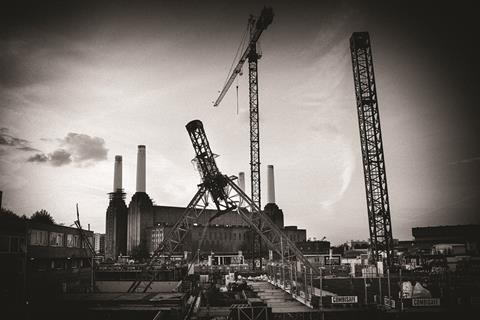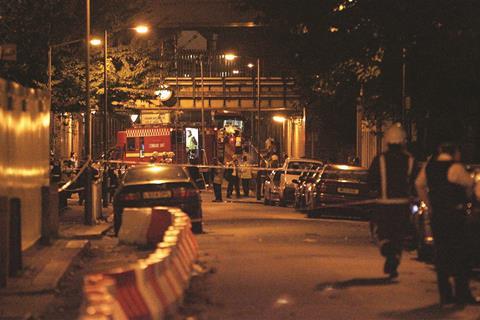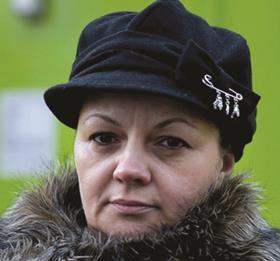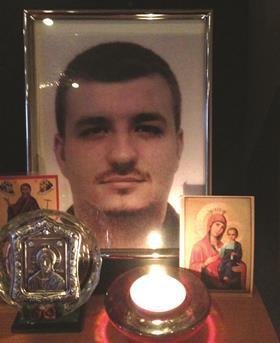Ten years after the Battersea crane tragedy, Joey Gardiner talks to the mother of one of the two men killed in the accident and asks if tower cranes are any safer now than they were a decade ago

On 26 September 2006 Liliana Alexa’s son, Michael, was changing the wheel of his car in the road outside his house in Battersea, south-west London, when bolts attaching the top of a nearby crane to the mast sheared, sending the cab and jib crashing down on the streets below. According to Liliana, local eyewitnesses report 23-year-old Michael pausing to get children playing outside a local shop out of the way as the crane started to fall. By the time Liliana was at the scene, all she could see was her son’s body under the wreckage. “That image will follow me forever,” Liliana says, 10 years on. Emergency services took nearly four days to clear away enough of the debris to allow them to remove his remains. The crane’s driver Jonathan Cloke was also killed.
As well as Liliana, Michael left behind a partner and baby son, Joshua, and a younger brother and father. “It is beyond my ability to describe. Really, I never imagined I could live through this, but somehow God gives us power,” she says. “It affects me in every single way. You cannot believe that something like this could happen to your child. Never.”
Last month Liliana finally received a measure of justice for the loss of her son, with the conclusion of a Health and Safety Executive (HSE) prosecution against the company that owned and ran the crane, Falcon Crane Hire. Falcon was fined £750,000 for safety lapses which led to the two deaths, and ordered to pay a further £100,000 legal costs. The firm’s managing director, Douglas Genge, avoided personal prosecution after the firm last autumn finally agreed to admit guilt. Nevertheless, the continued anger of Liliana, who set up the Battersea Crane Disaster Action Group to campaign about crane safety after the tragedy, about both her loss and the way the industry operates is palpable. Health and safety campaigners say little has changed in the industry since, with the previous government actually removing regulation put in place in the wake of the tragedy in a bid to cut health and safety red tape. While the faults that led to the Battersea tragedy have now been exposed in court, questions remain over whether the industry as a whole has learned the lessons from it and other crane-related incidents.
I think [crane safety] is better than before. [But] it’s not 100% because they always always will put profit before safety
Liliana Alexa, mother of Michael Alexa
Why the accident happened
Numerous investigations, including by the HSE, the Crown Prosecution Service and the coroner into the deaths of the two men, have established what happened at the Barratt Homes site on Thessaly Road where the Falcon crane collapsed. In the words of the HSE, the 24 bolts that failed were a “significant safety feature” connecting the slew ring - the circular cog at the top of the mast on which the arm or jib of the crane rotates - to the cabin and jib of the crane. Michael Alexa’s coroner found that, unbeknownst to Falcon, its operators were using a crane manual in which the sheet detailing the amount of counterweight needed referred to a different model - the BPR 222B rather than 222. This resulted in 12 tonnes of counterweight being loaded on to the crane, far more than correctly specified, putting additional strain on the bolts.
Falcon was found culpable for the incident because two months earlier, on 25 July, four slew bolts had failed on the same crane. Rather than take the crane out of service to investigate the reason behind the failure, Douglas Genge instructed the team running it to replace all 24 bolts and put the crane back in service - which happened the next day. While the coroner did not allow a verdict of unlawful killing to be recorded because the crane’s manual had not been clear what action should be taken in the event of slew ring bolts failing and there was no mandatory requirement to take it out of service, the jury in the inquest concluded that: “At that time there was no adequate formalised process and procedure to allow for faults to be managed, escalated or investigated. In addition there was a vacuum of structured management in the service department.” After the fine was handed down last month, the HSE said in a statement that “the bolts failing previously was an exceptional and significant occurrence, which should have been recognised by Falcon Crane Hire,” and that the firm’s process to investigate the underlying cause of components’ failings was “inadequate”.

Mike Wilcock, HSE head of operations, branded the deaths “tragic, needless and entirely avoidable”. “These two men need not have died had Falcon Crane Hire taken the right, decisive action,” he said.
For Liliana, of course, this public victory is no compensation for the distress she and the rest of the two dead men’s families have suffered. “They never thought about the consequences. They killed two people. But they didn’t kill two people, they killed all of us. And two children grow up without a father.
“After this, I could not work for eight years. I did not leave the house, I stayed indoors and closed the curtains.
“I still expect to see him, you know. Sometimes I search [for] his face to see him, and places we used to go, like supermarkets and on the street. So many times,” she says. She helps look after Michael’s son, who will be 10 this summer, taking him regularly to visit Michael’s grave. “He’s missing his father. He never knew his father.”
At the time the Battersea collapse was very far from a one-off. In May 2000 three people were killed in a tower crane accident in Canary Wharf, and in February 2005 two more people were killed by a collapsing BPR crane in a construction site in Worthing. By the time the Battersea incident occurred, the HSE had already declared a “blitz” of inspections on tower cranes. After Battersea, things got worse: a further fatal accident in Liverpool early in 2007, where Falcon was again the operator. This saw the HSE order Falcon to take all of its cranes that hadn’t been independently inspected out of service immediately.
Industry response
This sense of crisis did at least engender some action. In early 2007 the HSE rushed out a safety alert on the use of tower cranes, while the industry’s Strategic Forum set up a tower crane group to address safety concerns. In response to a growing recognition that the regulations covering tower crane inspections, known as LOLER, and maintenance, known as PUWER, weren’t prescriptive enough in describing how they should be met to ensure good practice, the industry drafted guidance to ensure crane operators had robust safety processes. Meanwhile, a number of large main contractors drew up much stricter internal procedures to ensure crane subcontractors were working safely. Speaking to Building in 2007, Genge said Falcon had doubled the rate of independent inspections, conceding paperwork had been “a bit slack”, and led calls for tighter regulation.

At the same time a head of steam began to grow around the idea of a public register of tower cranes, supported by an editorial campaign by Building, so it could be seen if regulations had been met. Genge called the idea “excellent”, and in 2009 the then work and pensions minister James Purnell backed it, describing it as something that “could make a real difference to the safety of people who work in construction”. It became mandatory in April 2010, and for safety campaigners it felt like progress was being made. Liliana herself said at the time she was “very very happy” about the law.
However, this victory was short-lived. As part of its drive to cut red tape, the coalition government revoked the register, though it cost the £100bn-turnover construction industry just £50,000 per year to run, after the Löfstedt review of health and safety rules concluded it wasn’t making cranes safer. Needless to say, safety campaigners disagreed with this view, and Liliana described the move as “shameful”. The suspicion was, as Paul Street, project manager of the London Hazards Centre (LHC), says, that the move was “taken after lobbying from the industry”. However, this is denied by Tim Watson, consultant to the industry body which drafted revamped guidance in 2008, the Tower Crane Interest Group, part of the Construction Plant-hire Association (CPA). In reality many parts of the industry supported it, backing Building’s Safer Skylines campaign. “We were pretty neutral about the register and happy to do what was required, though I don’t think it did have much impact on health and safety,” Watson says.
Another big improvement asked for by campaigners in the wake of the Battersea tragedy was that the “thorough examinations” required under LOLER whenever a tower crane was installed were carried out by an independent examiner. While the 2008 guidance produced by the CPA’s Tower Crane Interest Group recommends using third party firms and makes clear that thorough examinations should not be carried out by “any member of the erection team”, this remains best practice, not law. The group’s consultant, Watson, says the reality is the “vast majority” of firms now use independent inspectors, with many main contractors commissioning a second independent check themselves on top of that commissioned by the crane operator. However, he concedes no figures exist for the proportion of checks done independently, and notes that in many European countries the state intervenes directly - something called for by Falcon’s Genge in 2007 after he questioned the experience of inspectors. “The HSE doesn’t have the resources to regulate in detail on the ground. This is a political issue,” Watson says. LHC’s Street says this is not good enough. “We’re calling for all cranes to be tested by inspectors who are properly independent,” he says.
The HSE says it is not able to provide specific data on tower crane accidents, so 10 years on it is hard to know exactly how the industry is performing. Certainly, since 2007, there have been enough serious incidents and fatalities in the UK - including a worker paralysed when a crane collapsed at a Bowmer & Kirkland site in Liverpool in 2009, and the collapse of a crane jib on Balfour Beatty’s Providence Tower scheme in 2014 - to suggest the problem is not entirely in the past. Watson, however, is optimistic. “The industry has changed, it’s become more professional and people now have much better procedures. We can never say never about future accidents, but it’s much less likely than before,” he says.
Changed - but far enough?
In a statement after the conclusion of the trial, expressing “sincere condolences” to the families of Michael Alexa and Jonathan Cloke, Falcon Crane Hire, for one, said it had re-examined all its procedures. “Where lessons could be learnt, they have been, where different methods of work could be used, they have been implemented and where higher level of skills could be attained, the necessary training has been given.”
Unsurprisingly, when it comes to the sector as a whole, many disagree with this positive take. Street says: “In terms of an overall industry approach, there’s nothing to suggest things have changed, and in the current deregulatory environment this is very unlikely to change”. Peter Farrell, chairman of the Construction Safety Campaign, describes the current approach as essentially “self-regulatory”. “It is far cheaper for operators to ignore safety,” he says.
Liliana herself believes very strongly that new regulation is needed, but concedes the industry has made some progress. “Of course I was angry when the register was repealed,” she says. “But I think it [crane safety] is better than before. I think it’s happening but I’m not sure in what percentage. It’s not 100%, because they always always will put profit before safety. That is my belief.”
No amount of reform can change the past for Liliana. Falcon didn’t respond to requests for comment for this feature but in 2007 Genge told Building, after the Battersea and Liverpool collpases, the incidents had a huge impact on the firm, with some employees undergoing counselling. He said: “It’s affected me, it’s affected my family, it’s affected so many people. It’s been terrible.”
But this contrition from Falcon Cranes cannot let Liliana forgive them for the mistakes that led to her son’s death. The campaign to improve crane safety through the Battersea Crane Disaster Action Group will, she says, continue, as will her struggle to cope with the event that changed her life forever. “It’s the end,” she says, referring to the legal process. “But I’m still with my thoughts, and doing my prayers, and thinking about my son. I will try not to think about anything else. I don’t want to think of Douglas Genge or the company. It won’t help me in any way.”




























No comments yet